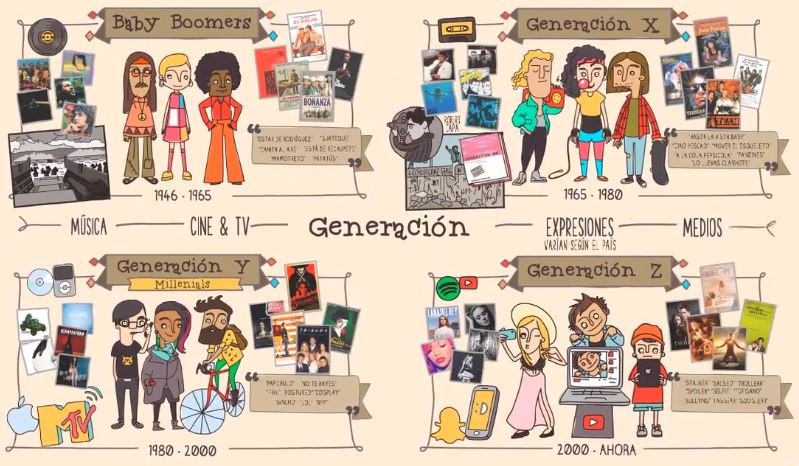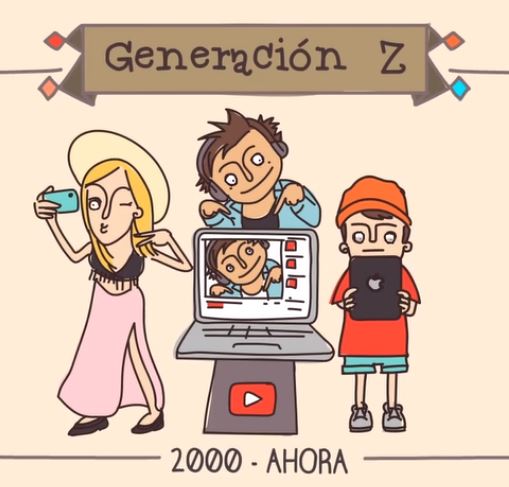If you are Spanish, this is the classification of generations according to your year of birth:
Baby boom (1949-1968)
Unlike the post-war children, the baby boomers are the largest generation. There are currently more than 12 million baby boomers in Spain. They were the first to live in peace and prosperity after the post-war period.
Generation X (1969-1980)
These are the children of the baby boomers, those born in the 1970s. In Spain they also lagged behind the rest of the Western world due to Franco’s regime and began with the progressive political opening up of the country. They lived through the splendour of consumerism and the obsession for success at all costs. Also known as the EGB generation, they were the first to become familiar with computers as a work tool.
Millennials (1981-1993)
Probably the best known and most criticised generation. Millennials are those born between 1981 and 1993 (or 1996, depending on the organisation consulted). In Spain they represent a population of just over 7 million men and women.
Generation Z (1994-2010)
This is the generation that has taken over from the millennials. They are at most 23 years old and outnumber their predecessors. In Spain there are 7,800,000 boys and girls who belong to this post-millennial generation.

Do you know which generation you belong to?
A study reveals that Millennials and Generation Z tend to build a more cryptocurrency-friendly society.
Bitget published an extensive study on the relationship between demographic changes and cryptocurrency adoption rates across generations. The brokerage examined more than 255,000 questionnaires, with participants from 26 countries and divided into four age groups.



The analysis found that the Millennial generation represents the largest group of cryptocurrency enthusiasts, accounting for 46% of respondents, and concluded that the representation of different groups by public regulatory bodies may define the possibility of social changes favourable to cryptocurrencies.
The survey was conducted between July 2022 and January 2023, involving more than 459,000 respondents, with more than 255,000 contributing responses. As part of the study, information on the fertility and adoption rate of cryptocurrencies in selected countries was correlated with other factors, such as the propensity of residents of selected countries to use blockchain technology and data on the demographics of people who own cryptocurrencies.
Respondents were categorised into generational and age groups: Baby Boomers, Generation X, Millennials, and Generation Z. Among them, Baby Boomers accounted for 19% of respondents, with 8% owning cryptocurrencies.
Generation X made up 23% of respondents, with 25% of them owning cryptocurrencies. Generation Y made up 31% of respondents and 46% of them owned a cryptocurrency, and Generation Z made up 17% of respondents and 21% of them owned a cryptocurrency. The statistics point to an uneven use of digital assets across different age groups, especially in countries with a long-life expectancy and a highly educated population, such as Japan.
The data collected also indicates that Millennials are more loyal to cryptocurrencies, as they are more familiar with the internet and digital technologies, compared to previous generations.
This age group is also starting to build their investment portfolios and sees cryptocurrencies as a good opportunity due to their high return potential, as shown from 2017. It was also observed that Generation Z respondents are fans of modern technologies, being inclined to use digital assets and DLTs, as they do not have any negative experience with financial crises, as they were born after 2008.
Other data collected on behaviour regarding the regulation of digital assets indicates that each passing generation is more interested in their rulers having an equal interest in the regulation of blockchain assets, with a considerable increase in the percentage from 6% to 27% between Generation X and Generation Y, respectively.
This jump can be attributed to the change in value mapping observed in these two generations, especially in relation to changes in technologies, work-life balance issues, diversity and inclusion factors, and a decrease in trust in institutions.
The influence of Baby Boomers and Generation X is likely to diminish, as by 2030 all members of Generation Z will be adults, and the diffusion of blockchain technology in this period could lead to an increase in the percentage of people using cryptocurrencies across all generations.
“The popularity and acceptance of cryptocurrencies varies across different age groups. Through this research, we can better understand the needs and preferences of cryptocurrency users,” he said Gracy Chen, CEO of Bitget.
Analysis of the overall data obtained during the research allows the Bitget team to conclude that population growth in the countries studied is, in general, slowing down.
Combined with increasing life expectancy, there could be a situation of total rejection of cryptocurrencies, blocking innovation and modern technology. However, the declining share of Baby Boomers and Generation X in the total population may be accompanied by processes of unlocking and rehabilitating solutions that benefit society and replacing conservatism with progressivism.
The research findings also suggest that, early in the next decade, demographic processes could lead to a dramatic shift towards greater acceptance of cryptocurrencies, despite the slowdown in population growth.
Source: Periodistadigital / Dailymotion / Cointelegraph
Disclaimer: The information set out herein should not be taken as financial advice or investment recommendations. All investments and trading involve risk and it is the responsibility of each individual to do their due diligence before making any investment decision.



